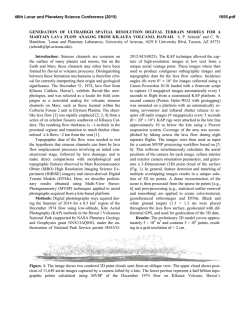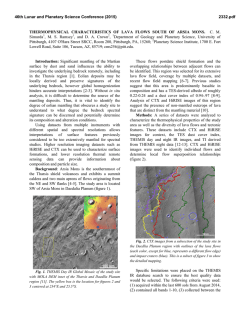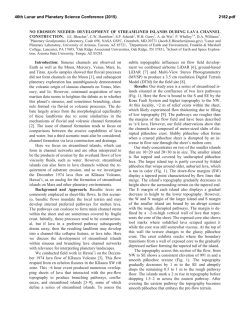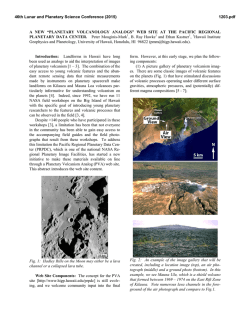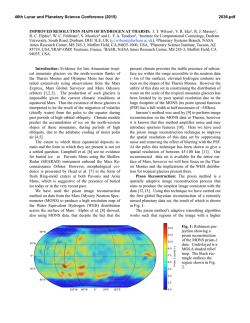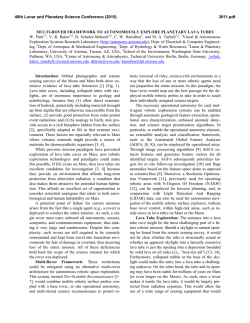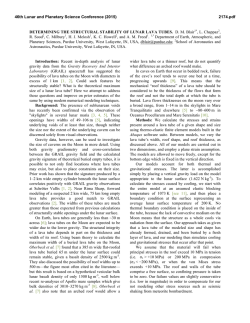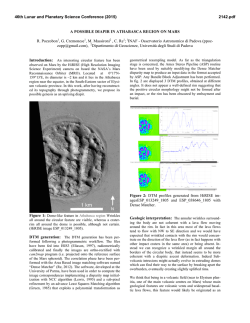
LAVA FLOW FIELDS OF SOUTHERN THARSIS, MARS: FLOW
46th Lunar and Planetary Science Conference (2015) 1439.pdf LAVA FLOW FIELDS OF SOUTHERN THARSIS, MARS: FLOW TYPES, INTERACTIONS, AND AGES. David. A. Crown1, Daniel C. Berman1, and Michael S. Ramsey2, 1Planetary Science Institute, 1700 E. Fort Lowell Road, Suite 106, Tucson, AZ 85719, 2Department of Geology and Planetary Science, University of Pittsburgh, Pittsburgh, PA 15260, [email protected]. Introduction: This research examines styles and sequences of volcanism in the southern Tharsis region of Mars. High-resolution images are being used to produce geologic and flow field maps of the region south of Arsia Mons and in Daedalia Planum [1-7; see also 9-11]. Mars Reconnaissance Orbiter Context Camera images (CTX; ~5 m/pixel) allow reconstruction of complex volcanic surfaces, including delineation of individual flow lobes and superposition relationships within a flow field. Populations of small, superposed impact craters are used to derive relative and absolute age constraints for individual flows and flow sequences. Study Area and Datasets: The current investigation focuses on a zone [22.5-27.5°S, 120130°W] within the extensive flow fields SW of Arsia Mons for which high-resolution image coverage is available. CTX images imported into ArcGIS are the primary image base used to map southern Tharsis flow fields. In order to fully characterize observed volcanic features, we also use the Mars Odyssey Thermal Emission Imaging System (THEMIS) global mosaic and infrared multi-band images (~100 m/pixel), High Resolution Imaging Science Experiment (HiRISE; ~25 cm/pixel) images, and Mars Orbiter Laser Altimeter (MOLA; 128 pixel/deg) DEMs and PEDR profiles. Flow Types: South of Arsia Mons, flow fields include numerous prominent, elongate, sinuous lava flows, many of which can be traced for 100+. Analysis of CTX images allows identification of two main lava flow types [1-5, 8]: 1) large, relatively thick, bright flows with rugged upper surfaces that display medial channel/levee systems and broad, distal flow lobes. Ridged, knobby, and platy surface textures are evident; and 2) small, relatively thin, dark flow lobes with mostly featureless surfaces that are typically associated with narrow lava channels or lava tubes. In Daedalia Planum, wider, less well-defined flow units are evident and coalesce to form a vast volcanic plain. Large, ridged, and sometimes platy, sheet flows along with presumed volcanic plains embay the cratered highlands at the southern margin of Tharsis [6-7]. Flow Ages: Using CTX images, populations of small impact craters superposed on lava flow surfaces have been analyzed and indicate an extensive history of volcanism across southern Tharsis [5-8] (Figures 12). Crater size-frequency distributions for a series of elongate flow lobes south of Arsia Mons (including both bright, rugged and dark, smooth flow types) indicate ages of ~100 My in the Late Amazonian Epoch. Crater size-frequency distributions for adjacent broad flow lobes and for sheet flows further SW in Daedalia Planum indicate ages ~1+ Gy in the Middle to Early Amazonian, with older volcanic plains exposed beneath the sheet flows at the southern margin of Tharsis. These results suggest a general decrease in age toward the center of Tharsis and that distinct sequences of flow emplacement characterize the Amazonian volcanic history of southern Tharsis. Flow Interactions and Flow Field Stratigraphy: CTX images reveal complex flow patterns and local interfingering and overlapping relationships in the study area [5]. Distinct embayment relationships are observed between and among the different types of flows recognized. Darker channel/tube-fed flows are commonly younger than the adjacent thicker, bright flows; however, this is not always the case, and the observed diversity and complexity of interactions between flows suggests that lava sources with different eruptive styles and magnitudes were active contemporaneously. Further to the SW (and consistent with the lower slopes) flow lobes widen and large sheet flows are observed where flows embay the cratered highlands. Observed characteristics of the dark flow type (including smoother upper surfaces, lesser thicknesses, more numerous, smaller lobes, and their channel/tubefed nature) indicate a lower viscosity lava than for the bright, rugged flows. Steep-sided and sometimes terraced margins and the presence of smooth-surfaced plateaus along lava channel/tube systems suggest morphologic similarities to inflation signatures in terrestrial pahoehoe flows [e.g., 12]. In addition, superposition relationships and surface morphologies within Arsia flow fields suggest complex interactions between flows; burial of one flow by another and sharp and gradational contacts between adjacent flows are apparent. Low viscosity dark flows are observed to “invade” rugged flow surfaces in different ways. In some cases, dark flows are captured by and resurface the lower-lying interior channel zones of rugged flows. In others, dark flows appear to inundate rugged flow surfaces but the larger topographic elements of the underlying rugged flow surface (e.g., flow ridges and impact craters) are preserved. 46th Lunar and Planetary Science Conference (2015) Future Work: Continued analyses of southern Tharsis lava flow fields will include morphologic and morphometric investigations of individual flow lobes and characterization of flow surface textures and thermophysical properties. Interactions between flows will be examined to document flow field stratigraphy. Flow field mapping and chronologic studies will constrain spatial and temporal patterns in the voluminous effusive volcanism that characterizes southern Tharsis. 1439.pdf References: [1] Crown, D.A. et al. (2009), LPSC XL, abstract 2252. [2] Crown, D.A. et al. (2010), LPSC XLI, abstract 2225. [3] Ramsey, M.S. and D.A. Crown (2010), LPSC XLI, abstract 1111. [4] Crown, D.A. et al. (2011), LPSC XLII, abstract 2352. [5] Crown, D.A. et al. (2012), LPSC XLIII, abstract 2138. [6] Crown, D.A. and D.C. Berman (2012) LPSC XLIII, abstract 2055. [7] Crown, D.A. et al. (2013), LPSC XLIV, abstract 2499. [8] Crown, D.A. et al. (2014) AGU 2014, abstract P41B-3906. [9] Bleacher, J.E. et al. (2007), JGR 112, doi:10.1029/2006JE002873. [10] Lang, N.P. et al. (2009), JVGR 185, 103-115. [11] Giacomini, L. et al. (2012), Icarus 220, 679-693. [12] Garry, W.B. et al. (2012), JGR 117, doi:10.1029/2011JE003981. 9 7 9 8 6 2 1 5 4 3 Figure 1 (above). Flow field map of NE Daedalia Planum region showing lava flow margins (red lines) and crater count areas for nine flow lobes. Count areas range from 72 – 6750 km2, and the number of craters counted for individual flows ranges from 69 – 1456. Figure 2 (left). Crater size-frequency distributions grouped by flow type. Results for parts of six elongate, sinuous flow lobes (red, flows 4-9) show ~100 My ages (Late Amazonian). Results for parts of three broad flow lobes (blue, flows 1-3) match the isochrons at larger crater diameters and indicate ~1 Gy ages in the Early to Middle Amazonian. 3 2
© Copyright 2025
